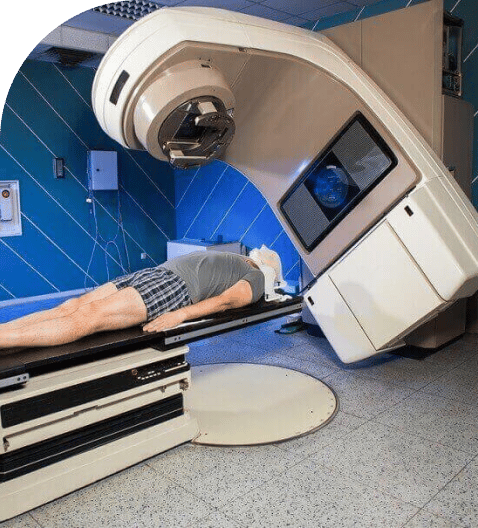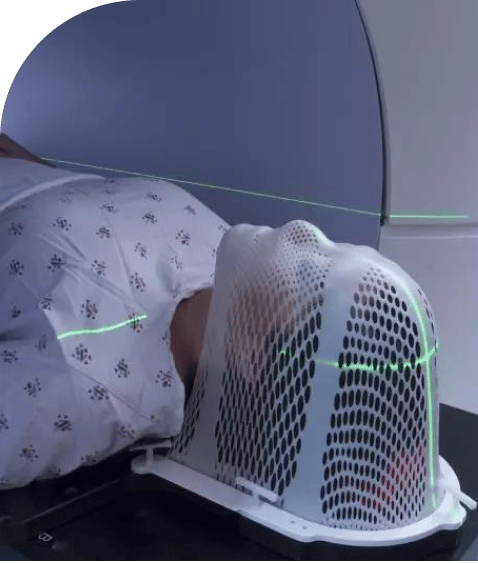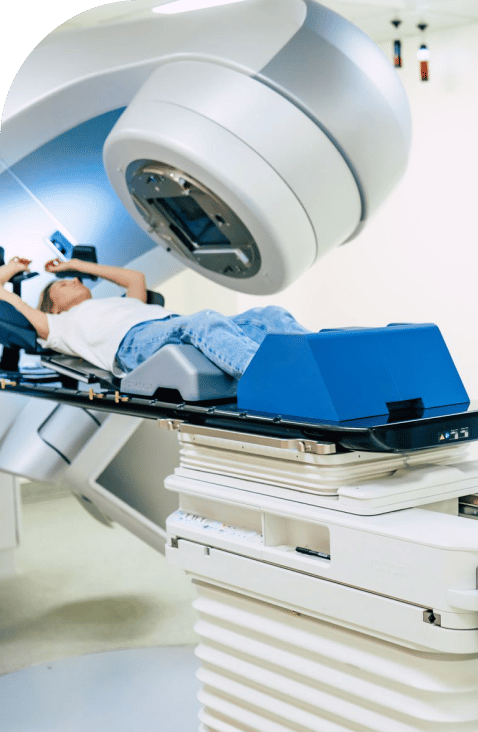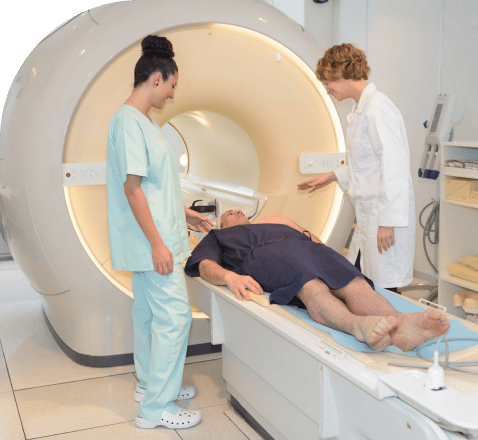Radiation Therapy for Mesothelioma
Radiation therapy is often used alongside surgery and chemotherapy to treat mesothelioma cancer. This type of therapy employs energy to damage and destroy cancerous cells. It can be used to maximize life expectancy or the quality of life in mesothelioma patients, known as palliative care.
Home » National Mesothelioma Law Firm » Mesothelioma Cancer » Mesothelioma Treatment » Radiation Therapy for Mesothelioma
Types of Radiation Therapy for Mesothelioma
Radiation therapy targets cancer cells using high-energy X-rays or particles. The energy of the radiation causes small breaks in the DNA of cancer cells. This DNA damage prevents these cells from growing and dividing. The radiation also triggers a process of natural cell death so that the cancer cells will die off over a period of time following radiation.
In addition to damaging cancer cells, radiation therapy can also damage the DNA of other cells in the area. Radiation is most potent at causing damage to cells that are in the process of dividing. Because cancer cells generally divide very rapidly, they’re the most affected by the radiation.
However, some other cells, such as skin cells, also divide regularly throughout a person’s life, so they tend to be affected by radiation therapy. This can lead to side effects from this mesothelioma therapy, such as skin irritation or blistering in the treatment area.
Radiation therapy is also known as radiotherapy; the two terms are interchangeable and mean the same thing.
There are a few different forms of radiation therapy that can be used for cancer treatment.
External Beam Radiation Therapy (EBRT)
There are two different forms of radiation that may be used in EBRT. The most common type of radiation used in EBRT is a photon beam, which is made up of high-energy X-rays. These are the same type of X-rays that are sometimes used to take images of the body. However, in radiation therapy, they’re used at a much higher and more concentrated dose in order to target the cancer cells.

However, proton beam radiation is extremely expensive, and with advances in the technology of photon beams, the advantage of protons is less clear. This is why photon beam radiation (using X-rays) is the most common form used in the treatment of mesothelioma and most other cancers.

Intensity Modulated Radiation Therapy (IMRT)
Brachytherapy
Brachytherapy is another type of radiation therapy that is sometimes used to treat various cancers. It involves placing a source of radiation inside the body rather than directing radiation at the body from the outside. Radioactive capsules may be placed inside the body temporarily during surgery and then removed before the incisions are closed, or they may be implanted into a particular area and left in place to slowly deliver radiation over the following weeks.
Brachytherapy isn’t currently used as part of standard clinical practice for mesothelioma, but this method is being studied. A study of brachytherapy published in 2005 didn’t show that it was effective for pleural mesothelioma patients, but researchers are continuing to look at it as a potential future treatment for mesothelioma. Some cancer centers do use brachytherapy to treat certain mesothelioma patients, even though its use is considered experimental.

Methods of Radiation Therapy for Mesothelioma
In general, radiation is not part of the treatment plan for peritoneal mesothelioma patients. Instead, the gold standard treatment for this disease is CRS-HIPEC, which combines surgery and chemotherapy. Radiation may be used in palliative care for peritoneal mesothelioma patients, but it is rarely used as part of a curative treatment plan.
However, for pleural mesothelioma patients, radiation is commonly incorporated into the treatment plan. There are a few different ways that it may be used.

Adjuvant Radiation Therapy
Adjuvant radiation therapy is used after surgery in order to decrease the chances that the cancer will return. Usually, adjuvant radiation therapy is started a few weeks after a surgical procedure to allow adequate time for healing after surgery.
One common use of adjuvant radiation therapy is to prevent seeding. During surgery, there is a theoretical possibility that a few cancer cells will travel along the incision sites, which would lead to the cancer spreading through the body. Many patients receive radiation therapy along their incision lines in order to target any cancer cells that may have been spread during the surgical procedure itself. The American Society of Clinical Oncology doesn’t recommend radiation along incision lines for all patients, but does recommend it in cases where cancer cells have been found along the incision.
Adjuvant radiation therapy can also be given to the half of the chest where the original tumor was found. This is known as hemithoracic adjuvant radiation therapy. It’s often used after extrapleural pneumonectomy (EPP), in which the lung on the affected side is removed, along with other tissues. This treatment is sometimes also used after pleurectomy/decortication (P/D), although the potential for toxicity to the lung makes it riskier in this case.
Neoadjuvant Radiation Therapy
Neoadjuvant radiation therapy is given before surgery. This may be used to attempt to shrink the primary tumor in order to make it easier to remove with a surgical procedure. It may also help to target mesothelioma cells that have moved away from the primary tumor mass.
A recent clinical trial known as the SMART trial examined the use of neoadjuvant radiation therapy. Patients received hemithoracic radiation therapy, given to the half of the chest where the primary tumor was located. A few days after completing the course of radiation, they then underwent extrapleural pneumonectomy (EPP), an invasive surgical procedure that removes the lung and other tissues on the affected side.

The three-year survival rates were as high as 70 to 80 percent in patients with the epithelioid cell type, which represents a significant improvement over the usual prognosis for pleural mesothelioma. Although this was a relatively small study and further research is needed, these results are promising and indicate that neoadjuvant radiation therapy may be highly effective for pleural mesothelioma.
The rationale behind giving radiation to one whole side of the chest is that many patients have a malignant pleural effusion. This is a buildup of fluid between the two layers of the pleura. Cancer cells can spread within this fluid, so they can be present in any part of the chest. Giving radiation therapy to one half of the chest helps to target any cells that may have traveled in the fluid to any part of the chest.

Intraoperative Radiation Therapy
Another approach is to use external beam radiation therapy directly on the site of a tumor while the area is exposed during surgery. This allows a concentrated dose of radiation to be used directly on the site of the tumor to decrease the chances that it will return after the surgery.
Some studies have shown that intraoperative radiotherapy may be an effective part of a treatment plan for pleural mesothelioma. It can be used along with adjuvant radiation therapy.
Radiation Therapy for Recurrent Mesothelioma
Another common use of radiation therapy is to target an area where mesothelioma has recurred. After surgery, if a tumor starts to grow back, radiation therapy can be used to target this new cancer growth, slowing the progress of the disease. It’s recommended that radiation therapy is used on recurrent tumors even before they cause symptoms.
However, the total dose of radiation that can be safely delivered to a particular area is limited. If radiation therapy has already been used as part of a patient’s treatment plan, then it may not be possible to use it again when the cancer recurs.

Palliative Radiation Therapy for Mesothelioma
While the treatment plan for some mesothelioma patients is focused on achieving the maximum possible life expectancy, there are other patients for whom treatment is focused on maximizing the quality of life rather than on extending life. This is known as palliative care.
Radiation therapy can be used in palliative care. Most commonly, it’s used to shrink tumors that are causing significant symptoms. For example, in patients with pleural mesothelioma, a tumor may put pressure on an airway, causing uncomfortable symptoms like shortness of breath. Radiation therapy can be targeted to that tumor, helping to shrink it to relieve the symptoms.

Although radiation therapy is not commonly used as part of a life-extending treatment plan for peritoneal mesothelioma patients, it’s more commonly used in palliative care. For example, radiation therapy could be used to shrink a tumor that’s causing an intestinal blockage in order to relieve symptoms and make the patient more comfortable.
Palliative care and life-extending treatments are not mutually exclusive. Even if a patient is receiving treatments aimed at maximizing mesothelioma life expectancy, treatments aimed at reducing symptoms and improving comfort can also be used. These patients may receive radiation therapy to target particular tumors that are causing symptoms as long as the total dose of radiation delivered to the area is within safe limits.
By submitting this form, you agree to our terms & conditions. Please read full disclaimer here.



